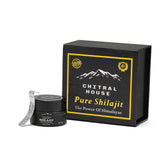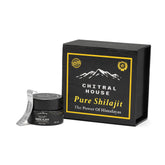Shilajit, a profound substance harvested from the towering peaks of the world's most formidable mountain ranges, has earned a title that speaks volumes about its rarity and value: the “Black Gold of the Himalayas”. This evocative name is far more than a simple marketing slogan; it is a direct reflection of its challenging origin, its unique physical properties, and the unparalleled treasure trove of health benefits it has offered humanity for millennia. To understand why Shilajit commands such respect, one must delve into its complex genesis, its astonishing composition, and its celebrated status in ancient healing systems.
The Genesis: A Millennial Earthly Elixir
The term “Black Gold” first and foremost references the extraordinary and arduous process by which Shilajit is formed. It is a natural mineral- and herb-based exudate — a sticky, dark, tar-like resin that seeps from the rocks of the Himalayas, the Karakoram, the Caucasus, and the Altai mountains.
Shilajit's formation is a geological and biological marvel that takes centuries, if not millennia. It begins as vast forests and plant matter, rich in nutrients, become trapped and compressed by layers of rock as the mountains rise. This organic material, including mosses, lichens, and specific plant species like Euphorbia royleana and Trifolium repens, undergoes a profound transformation. Under intense pressure and temperature, and with the aid of microbial decomposition, the plant matter slowly breaks down into a potent, organic-rich biomass.
The “harvest” of this “gold” is reserved for the summer months. As the mountain temperature rises, the heat softens the compressed matter, causing the blackish-brown resin to ooze out of rock crevices and fissures — a phenomenon often poetically referred to as “rock sweat” or “mountain tears.” The difficulty in extracting this remote and slow-forming substance from high altitudes immediately contributes to its reputation for rarity and preciousness, akin to finding a gold vein deep within the earth.
The Appearance: A Literal Interpretation of “Black”
The “Black” component of the nickname is quite literal, describing the substance's physical characteristics. Pure, high-quality Shilajit resin ranges in color from a dark brown to a deep, lustrous black. At room temperature, it has a semi-solid, sticky consistency, which hardens and becomes brittle when cold, and softens or dissolves when warmed. It is often described as having an earthy, smoky, or slightly bitter taste and a distinctive, strong odor — sometimes likened to stale cow’s urine, which is actually a traditional sign of authenticity. This dark, rich, almost tar-like appearance sharply contrasts with its immense inner value, underscoring the “gold” metaphor.
The Value: An Unparalleled Chemical “Gold” Standard
The true value — the “Gold” — of Shilajit lies in its complex and potent chemical composition, which makes it an unrivaled nutraceutical compound. It is revered because it is a dense source of organic and inorganic elements that are essential for human vitality.
The Fulvic Acid Advantage
The single most valuable component of Shilajit is Fulvic Acid, which can constitute anywhere from 60% to 80% of its bioactive mass. Fulvic acid is a powerful, naturally occurring humic substance that acts as the body’s primary nutrient “delivery system.” Its unique chemical structure allows it to chelate (bind with) minerals and carry them across cell membranes with exceptional efficiency, ensuring that the body absorbs nutrients and minerals that might otherwise be expelled. This function alone elevates Shilajit to the status of “gold,” as it boosts the effectiveness of all other nutrients consumed. Fulvic acid is also a potent antioxidant, protecting cells from free-radical damage, and is known for its anti-inflammatory properties.
The Mineral and Trace Element Treasure Trove
Beyond Fulvic Acid, Shilajit is an abundant reservoir of over 80 trace minerals in their ionic form — meaning they are easily assimilated by the body. This includes vital elements such as:
- Iron: Crucial for blood formation and energy.
- Magnesium: Essential for muscle and nerve function, and energy production.
- Zinc: Important for immune function and cell growth.
- Copper, Manganese, and Potassium: All necessary for various metabolic processes.
The density of this broad spectrum of bioavailable minerals distinguishes Shilajit from standard mineral supplements, reinforcing its image as a priceless resource.
The Legacy: “Gold” in Ancient Medicine
Shilajit’s reputation as “Black Gold” is cemented by its historical and revered role in ancient medical systems, particularly Ayurveda, the traditional Indian system of medicine, where it has been utilized for over 3,000 years.
In Sanskrit, the word Shilajit literally translates to “Conqueror of mountains and destroyer of weakness.” This name perfectly encapsulates its two primary functions in traditional medicine:
- Conqueror of Mountains: It was historically used to help the body combat the stresses of high-altitude environments, improving energy, reducing symptoms of altitude sickness (like lethargy and hypoxia), and promoting adaptation to harsh conditions.
- Destroyer of Weakness: As a Rasayana (rejuvenator and restorative tonic), it was prescribed to combat ailments linked to fatigue, chronic weakness, and aging. Ancient texts such as the Charaka Samhita and the Sushruta Samhita extol its virtues as an unparalleled restorative tonic that increases physical strength, boosts energy, and promotes longevity.
Modern science is gradually catching up to these ancient claims, with studies investigating its potential for:
- Boosting Energy (Mitochondrial Function): Research suggests Shilajit enhances mitochondrial function, increasing cellular energy production (ATP).
- Cognitive Support: Its anti-inflammatory and antioxidant properties, particularly from Fulvic Acid, are being studied for potential benefits in preventing cognitive decline.
- Hormone Regulation: Clinical studies indicate that Shilajit supplementation may help increase testosterone levels in healthy males, further establishing its role as a vitality booster.
In conclusion, Shilajit’s title as the “Black Gold of the Himalayas” is a multifaceted tribute. It is “Black” for its color — a dark, resinous substance that is difficult to find. It is “Gold” because its exceptional and powerful composition — dominated by Fulvic Acid and a vast array of ionic minerals — imparts incredible, life-enhancing value. And it is “of the Himalayas” because this remote, majestic, and geographically unique origin is the crucible that gives birth to this millennia-old, natural powerhouse of vitality. It is a genuine earthly treasure, well deserving of its golden moniker.








